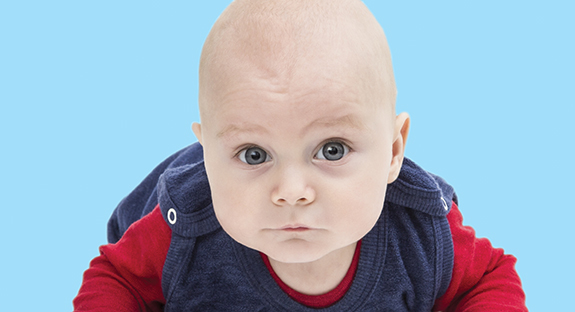What Do Babies Have in Mind?
Melissa and Klaus Libertus have two children. Like most parents, they’re fascinated to see their children grow, develop, and enter new life stages. But they also have a deeper interest in such things because both parents are cognitive-science researchers. In their professional lives, they are each working to understand the minds of the very young on a large scale. Melissa Libertus, who earned graduate degrees in psychology and neuroscience from Duke University, is investigating how and why babies who show a more precise understanding of numbers early in life turn out to be better at math as preschoolers than those who have a harder time distinguishing quantities as an infant. Klaus Libertus is exploring the association between infants’ motor skills and their social-cognitive development, finding, for instance, that poor grasping skills in infancy may be related to a child’s risk of developing Autism Spectrum Disorders. He earned his graduate degrees in experimental psychology from Duke and worked for three years at the Kennedy Krieger Institute in Baltimore.
and Klaus Libertus have two children. Like most parents, they’re fascinated to see their children grow, develop, and enter new life stages. But they also have a deeper interest in such things because both parents are cognitive-science researchers. In their professional lives, they are each working to understand the minds of the very young on a large scale. Melissa Libertus, who earned graduate degrees in psychology and neuroscience from Duke University, is investigating how and why babies who show a more precise understanding of numbers early in life turn out to be better at math as preschoolers than those who have a harder time distinguishing quantities as an infant. Klaus Libertus is exploring the association between infants’ motor skills and their social-cognitive development, finding, for instance, that poor grasping skills in infancy may be related to a child’s risk of developing Autism Spectrum Disorders. He earned his graduate degrees in experimental psychology from Duke and worked for three years at the Kennedy Krieger Institute in Baltimore.
Recently, Melissa Libertus, a newly hired Pitt assistant professor of psychology, research scientist at Pitt’s Learning Research and Development Center (LRDC), and director of The Kids’ Thinking Lab at LRDC, coauthored a paper published in the Proceedings of the National Academy of Sciences that finds this:
“… preverbal number sense in 6-month-old infants predicted standardized math scores in the same children 3 years later. This discovery shows that number sense in infancy is a building block for later mathematical ability and invites educational interventions to improve number sense even before children learn to count.”
This work in conjunction with her work on the brain processes that underlie this early number sense helped earn her the 2014 International Mind, Brain, and Education Society (IMBES) Early Career Award that she will officially receive at the IMBES conference in Fort Worth, Texas, in November of this year.
The next question, she says, is to find out “what are the kinds of things that parents do when kids are very young that might affect a child’s ability? When parents play with their children, how much do they talk about numbers? Is it helpful to point out numbers to kids more often?”
Klaus Libertus, a postdoctoral fellow and LRDC research associate, reports in a paper currently in press in the journal Child Development that poor grasping skills in infancy may be related to a child’s risk of developing Autism Spectrum Disorders, suggesting that grasping skills should be included in Autism screening and intervention efforts.
“In a way, grasping is the start of everything,” he says. “Only through grasping, can the child learn about object features such as weight and shape. Once an object has been grasped, the child can share it with a parent and engage in something called ‘joint attention’ with others. Grasping really opens up a rich set of opportunities for learning.”
The next steps for Klaus Libertus are to identify ways to help children who show poor grasping skills. “We know that grasping is important for a child’s development, and now we also know that children at risk for Autism Spectrum Disorders have difficulties with grasping.” To help such children, Klaus Libertus uses “sticky mittens” – Velcro covered mittens and toys that help infants ‘pick-up’ objects on their own.
“Sticky Mittens allow us to target the grasping skills very early in development, and may help some children who would otherwise miss out on the learning opportunities provided by the act of grasping an object.”
“People often think that we must be the best parents because we study child development,” says Melissa Libertus, “but the truth is that it’s not that easy. We are far from knowing enough to fully understand the vast individual differences that shape each child’s development. The more families we can engage in our research, the closer we can get to a complete picture. We are excited to welcome all of the Pittsburgh families to our lab and show them that research can be fun and eye-opening at the same time.”
Other Stories From This Issue
On the Freedom Road

Follow a group of Pitt students on the Returning to the Roots of Civil Rights bus tour, a nine-day, 2,300-mile journey crisscrossing five states.
Day 1: The Awakening
Day 2: Deep Impressions
Day 3: Music, Montgomery, and More
Day 4: Looking Back, Looking Forward
Day 5: Learning to Remember
Day 6: The Mountaintop
Day 7: Slavery and Beyond
Day 8: Lessons to Bring Home
Day 9: Final Lessons

